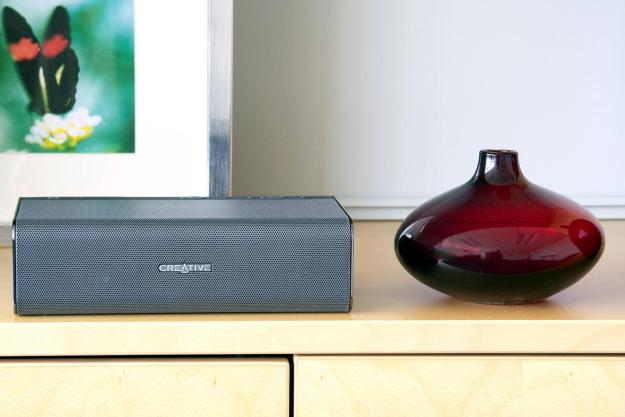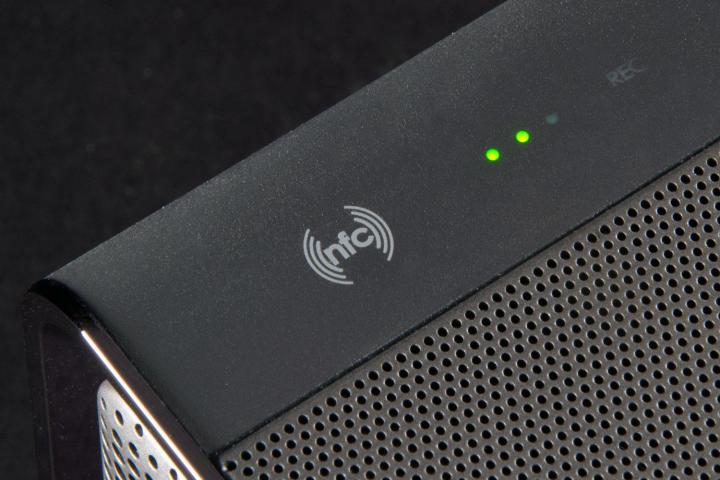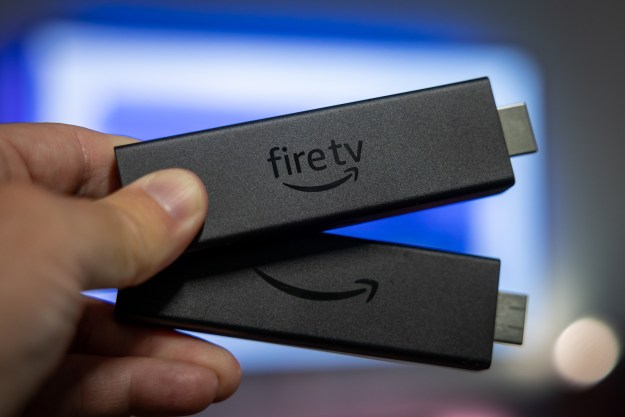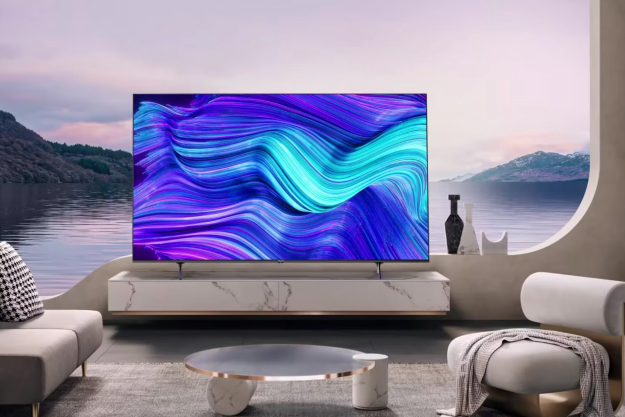
“The Roar is one of the most unique Bluetooth speakers we’ve tested.”
- Very loud for its size
- Roar and Tera Bass buttons serve their purposes
- Bluetooth and portable
- Number of extra features is unmatched
- Great value for $150
- Still bulky, even when folded in
- Uneven audio quality, depending on volume and genre
- About 6-8 hours of battery life
- Alarm feature is weird
‘Small speakers that sound big’ is such a common pitch these days, it’s almost lost its meaning. But that doesn’t stop Bluetooth speaker makers from doing their best to sell you on the idea. The market has become crowded with a category full of speakers that look like they’re on a diet, but try as hard as they can to sound voluptuous. Unfortunately, try as they may, most fail.
Going into our review of Creative’s Sound Blaster Roar SR20A, we hoped for better. Creative has a history of developing great-sounding gear that performs well beyond what you’d expect for the price. Turns out, we weren’t to be let down – the Roar lives up to its name, and then some. Aside from being loud enough to power a party, the Roar is capable of recording audio, serves as a Digital Audio Converter (DAC) for computers, and has an alarm function (think emergency siren). To be sure, this is a speaker that wears more than one hat.
Out of the box
There’s not a great deal in the box because most of what the Roar has is already built-in to the unit. Expect an AC power adapter and a micro-USB cable. Above that is a fold-out Quick Start guide that outlines the instructions on how to use each and every function the Roar is capable of – which is a lot, so keep this thing handy.
Features and design
Despite what its name implies, the Roar has what we call a ‘lean back’ look, courtesy of a speaker grille that wraps from the front and along the top. Inside, are five drivers with two amps and a built-in subwoofer. One amp is dedicated to the highs, while the other handles the mids and lows. The front speakers pump out the highs, the bass comes out of the sides with the mids pointing up from the top. The flatter form factor is a bit unusual compared to others on the market, but we didn’t mind with all that power packed in.
Along the top is a rubberized strip with the main functions — NFC, Bluetooth/Call, Volume up and down, the Roar audio enhancer button and the power button. There are also three LED light indicators for battery life, plus another for Bluetooth.
The back is stacked with all the extras the Roar offers. There’s the port for the power adapter, an Aux-In jack, USB port for charging mobile devices, micro-USB for computer connections and a microSD card slot for audio recording and playback. Next to that is the section playback controls for the card slot and alarm. Play, pause, skip forward, skip back, microphone on or off (for recording), shuffle or repeat, “Link Security” switch for swapping Bluetooth settings, the alarm button and the alarm arming switch.
With that lineup, fanning out the Quick Start guide was the only way to make sense of it all. Creative did a good job illustrating each feature in a way that was easy to understand, though it didn’t necessarily go into a lot of detail as to how each one can be used. We tested them all to find out what tricks the Roar had up its sleeve.
Audio performance
Calling this speaker the “Roar” was an apt choice. It’s loud. Very loud, in fact. We were quickly taken by the booming sound it was capable of when we took it up to 11.
It didn’t take long to figure out that while the Roar can blast music at loud volumes, it doesn’t necessarily treat all genres equally at equal volumes. As with any portable speaker, we could hear the distortion set in once we cranked up the volume to the limit, with noticeable differences, depending on what we pumped out. Playing Earth Wind and Fire’s On Your Face, the treble drowned the bass, yet found the effect much less pronounced when playing classic rock tunes like Led Zeppelin’s Black Dog and Aerosmith’s Walk This Way.
It was less forgiving for modern alternative tracks, where simple chord guitar riffs and vocals sacrificed other instruments, reducing stereo separation at louder volumes. This is less of an issue in cases where you may be hosting a party with lots of people chattering because the sound travels well, even in spacious rooms or backyards. Standing closer to the speaker revealed the shortcomings of going really loud, whereas keeping a distance still offered impressive sound above the background noise.
For regular daily usage, we managed to find a solution by noting that certain volume levels worked better for specific genres, all of which were loud enough to enjoy. Keeping the Roar effect off, while maintaining a reasonable volume level, benefitted house and hip hop tracks, simply because the lows managed well without being overtaken by the highs and mids, which the Roar effect skews more toward anyway. We settled on different respective levels for typical Top 40 pop, smooth jazz or 70s funk. Playing the long bass-heavy intro of SOS Band’s High Hopes was fine once we knew how far we could go, while the same was true of Sam Smith’s Stay With Me.
The Roar isn’t able to provide the kind of rumbling lows that other speakers in this category can dish out, but we did find a way to amplify that. The Tera Bass button in the back acts as a boost to the lows, offsetting the Roar’s effect. We noted much better feedback listening to Maxwell’s Ascension and Sade’s Bulletproof Soul, but because the range between Tera Bass and Roar is uneven, we preferred to keep the latter off when playing deeper bass tracks.
It’s unfortunate that preset volume levels aren’t among the litany of features Creative crammed into this thing. Even without that, using Creative’s Sound Blaster Control Panel software would be a welcome way to create presets and tinker on the fly. Problem is, there is no mobile app, only a desktop version that works for playback via a PC or Mac. Since the Roar’s primary purpose is as a Bluetooth speaker, we’re a little puzzled that kind of integration is missing.
Everything else
As a speakerphone, we found little to complain about. Callers could hear us clearly, and the only issues with clarity had more to do with reception than anything the Roar was doing.
The microSD card slot is usable for recording or playing MP3 and WMA files. It saves recordings in WAV format. We recorded a couple of phone interviews to gauge quality, but also experimented with recording tracks from streaming services, like SoundCloud and Songza. The recordings may be in WAV, but they are by no means CD quality. An eight-minute track from SoundCloud amounted to a file size of only 8MB. While we thought it cool to be able to record tracks this way, the quality was arguably worse than a low-bitrate MP3, rendering the feature useless for music. For voice, however, it’s perfectly fine. Playing music files copied to the card from a computer or mobile device is great, too.
The flatter form factor is a bit unusual compared to others on the market, but we didn’t mind with all that power packed in.
Creative claims up to eight hours of battery life for music playback depending on listening conditions. This decreases as the volume rises, and keeping the Roar or Tera Bass effects on also saps it further as well. We generally found that six hours was the average when listening above the default volume level. That’s not bad, but a fair bit behind some of the other portable speakers on the market. We can forgive the low number, since the speaker offers booming sound and works when plugged into a power outlet. In the latter instance, we sometimes plugged in our smartphone to charge, too.
We didn’t make too much use of it, but liked that the built-in DAC enhanced any music we played through a PC or Mac. It seemed only able to actually do that when plugged in via USB. We noted less impact when connected with a line-in cable or Bluetooth. The Sound Blaster Control Panel software is also only accessible via a USB connection.
The Alarm function is easily the most bizarre of all these rear features. The Quick Start guide mentions little about it, so we had to download the full manual online to know what to do. Switching to ARM and holding down the Alarm (also the Tera Bass) button for three seconds sets it up, except all it does is sound a screeching siren. We’re not clear on what this is for, other than maybe freaking out kids or herding them into single file to wake up in the morning.
Conclusion
The Roar is one of the most unique Bluetooth speakers we’ve tested. Ambitious and audacious, we can confidently say this is one of the best available for $150. The combination of sound quality, loudness and all the other extras it offers make it a worthwhile buy. It takes a little time to understand everything it does, as well as tinkering with volume and the various enhancing effects included, but the results are consistently good throughout.
In being able to handle essentially every genre of music, it caters to anyone, rather than being marketed specifically to a certain listener. It may not be the speaker you take to a camping trip, but if you’re looking to lounge to tunes on your own or host friends at home, you can’t go wrong here with the price.
Available from: Amazon
Highs
- Very loud for its size
- Roar and Tera Bass buttons serve their purposes
- Bluetooth and portable
- Number of extra features is unmatched
- Great value for $150
Lows
- Still bulky, even when folded in
- Uneven audio quality, depending on volume and genre
- About 6-8 hours of battery life
- Alarm feature is weird
Editors' Recommendations
- Marshall’s latest Bluetooth speaker has four drivers for 360 sound
- Edifier MP230 Hands-on Review: The pint-sized, retro Bluetooth speaker brings a vintage vibe
- Bose SoundLink Revolve, Revolve+ Bluetooth speakers are up to $80 off at Walmart










